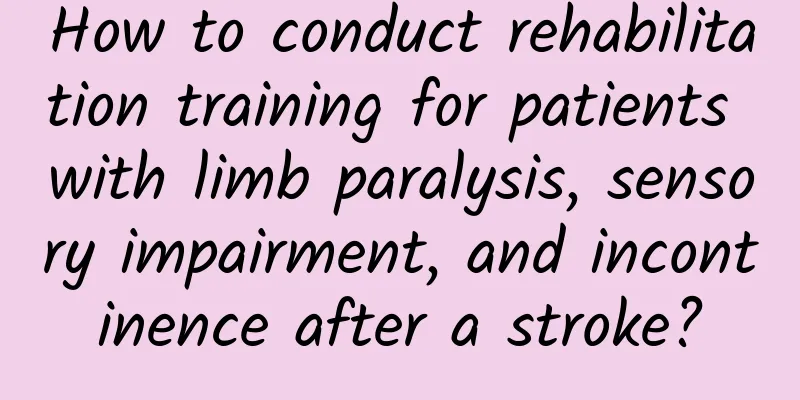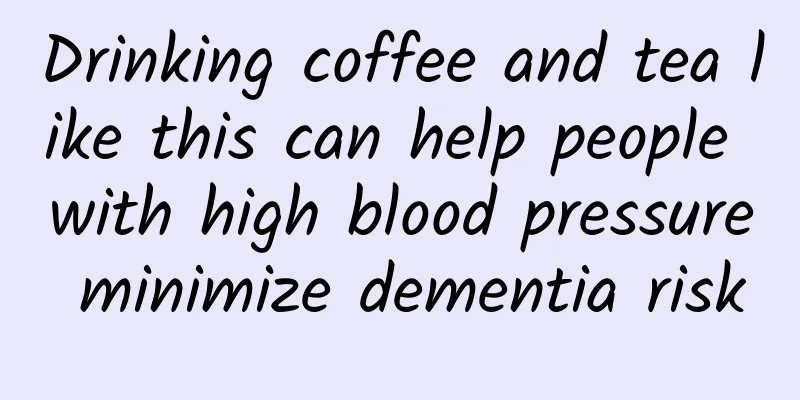How to conduct rehabilitation training for patients with limb paralysis, sensory impairment, and incontinence after a stroke?

|
Author: Wang Xinglin, Chief Physician of the First Medical Center of the General Hospital of the Chinese People's Liberation Army Reviewer: Wang Lixiang, Chief Physician, Third Medical Center, PLA General Hospital With the increase in the incidence of the three highs, hypertension, high blood sugar and high blood lipids, the incidence of stroke is also increasing. Stroke, also known as brain infarction, includes cerebral hemorrhage. Figure 1 Original copyright image, no permission to reprint The treatment of stroke is divided into three stages: acute stage, recovery stage and sequelae stage. The acute phase is when the patient first becomes ill, and different treatment methods are used depending on the location and type of the lesion. For stroke caused by cerebral thrombosis, thrombolytic therapy within 6 hours of onset generally has a better effect, because at this time, ischemia has not yet caused brain tissue degeneration and necrosis. After thrombolysis, the brain tissue has blood supply and the ischemic brain tissue can recover. If the onset exceeds 6 hours, the brain tissue is prone to degeneration and necrosis. At this time, thrombolysis is generally less effective. For stroke caused by cerebral hemorrhage, the head should be kept still in the acute phase, head vibration and large movements should be avoided, intracranial pressure should be lowered, and high blood pressure should be controlled to reduce the amount of intracranial hemorrhage in the patient. During the recovery period, targeted rehabilitation treatment, neuromuscular low-frequency electrical stimulation, etc. are mainly carried out according to the existing problems of the patients. For example, for hemiplegic limbs, corresponding motor function training and neuromuscular low-frequency electrical stimulation and other rehabilitation treatments are carried out. The sequelae stage is when the patient has recovered for a period of time and focuses on rehabilitation treatment for some symptoms that have not yet recovered, in order to minimize the sequelae of stroke. 1. How do stroke patients perform muscle training? First, exercise training. Passive exercise, active exercise, and resistance exercise can be used for training and treatment. Resistance exercise training is to set different resistance ranges according to the patient's muscle strength, thereby increasing muscle strength. Second, neuromuscular low-frequency electrical stimulation is used to stimulate muscle movement, increase muscle tension and strength, and promote the reconstruction of central nervous system motor conduction function through the input of proprioceptive nerves. Third, daily life activities training. Patients can participate in some daily life activities to improve the motor function of muscles. Through daily activity training, the muscle function of some patients has recovered significantly. Muscles are mainly responsible for the movement of the affected limbs and trunk, etc., increasing muscle strength and increasing the patient's joint movement strength are of great help to the patient's daily walking, shoulder, elbow, and hand function improvement. It should be noted that when stroke patients do muscle training, they should do it in small amounts and multiple times, and the amount of exercise should not be too intense at one time, so that fatigue can be recovered the next day after the exercise. 2. How to recover from sensory impairment after stroke? Movement stimulates recovery of sensation: Every time a patient walks or exercises, he or she knows it through the sensory nerves. The movement of the human body itself can stimulate the recovery of sensation. Direct stimulation of sensory nerves: Sensation is divided into deep and superficial. Deep sensation is mainly proprioception, which can be achieved through joint movement, squeezing muscles, and letting patients do some proprioceptive exercises; physical factor therapy, such as neuromuscular low-frequency electrical stimulation, stimulates limb movement, ankle joint movement, etc. Superficial sensation is mainly pain, temperature and coarse touch, and the recovery of sensory function can be promoted through corresponding methods, such as brushing the skin, neuromuscular low-frequency electrical stimulation, etc. 3. How to recover from facial and limb paralysis after stroke? Motor dysfunction is mainly manifested as muscle weakness and central facial paralysis, and motor weakness means paralysis. Central facial paralysis can promote functional recovery by stimulating the paralyzed areas of the face through low-frequency electrical stimulation of the nerves and muscles. Limb paralysis is recovered through motor function rehabilitation. Patients should pay attention to rehabilitation treatment in the early stage of bed rest, such as passive movement of joints, active movement, placement of joint functional positions and neuromuscular low-frequency electrical stimulation. Early rehabilitation treatment and maintaining joint mobility are very important for patients to resume walking and daily life activities in the future. Patients with insufficient muscle strength can recover through motor function training of corresponding muscle strength, such as active exercise, resistance exercise, neuromuscular low-frequency electrical stimulation and daily living activities. After hemiplegia, patients may experience flexor spasms in the upper limbs and extensor spasms in the lower limbs, especially contracture of the Achilles tendon at the ankle joint, which has a great impact on the patient's future walking. Therefore, it is very important to perform anti-spasm exercises in the early recovery period to prevent contracture of the Achilles tendon and other parts. Figure 2 Original copyright image, no permission to reprint After the patient is able to walk, the patient's movement balance should be adjusted according to the patient's gait, and coordination or corrective rehabilitation treatment should be performed for abnormal postures that occur during movement, such as foot drop, inversion, and knee hyperextension. Many paralyzed patients will experience a decline in whole body function due to lack of activity and long time in bed. During the recovery period, they must pay attention and carry out preventive and restorative rehabilitation treatments. 4. How to recover from incontinence of stool and urine after a stroke? There are two main reasons for incontinence of stool and urine: the first is that the patient has impaired consciousness and is in a coma, and does not know when to defecate or urinate, which will lead to incontinence of stool and urine; the second is that the patient's neuromuscular control ability is poor, and poor control ability can also cause incontinence of stool and urine. For patients with fecal and urinary incontinence, the local area must be kept clean and dry, especially for fecal incontinence. Feces may soak around the anus, which can easily cause skin damage and infection. It is very important to keep the local area clean and dry. For patients with impaired consciousness, the first thing to do is to promote the recovery of consciousness. After consciousness is restored, they will have the ability to perceive defecation and urination, and may be able to control defecation and urination by themselves. If consciousness is restored but incontinence of stool and urine still exists, the main treatments are exercise training and neuromuscular low-frequency electrical stimulation. Exercise training can include pelvic floor muscle training and walking training. Exercise training is very important. Exercise training itself can stimulate the motor cortex of the brain. When the excitability of the motor cortex increases, the ability to control urine and defecation will in turn increase. Figure 3 Original copyright image, no permission to reprint Neuromuscular low-frequency electrical stimulation stimulates the urethral sphincter and anal sphincter, directly stimulating sphincter contraction. Muscle contraction increases muscle strength and promotes motor nerve control of sphincter function through sensory nerve conduction pathways. 5. How can family members participate in the rehabilitation training of stroke patients? Family members should provide patients with timely psychological comfort and guidance. In the hospital, cooperate with medical staff to carry out relevant rehabilitation training, such as joint exercises, regular turning over, etc. In addition, rehabilitation training for stroke patients takes a relatively long time, and the time for treatment in the hospital is limited, so family members need to provide more and more professional help, such as helping patients with joint exercises and walking training. Rehabilitation training after stroke is a long process. Patients and their families must build up confidence. It is very important to prevent recurrence of stroke during the rehabilitation process. Medication is essential. In addition, attention should be paid to diet. A balanced diet is very important. |
<<: Dry eyes due to "lack of water"? Actually it's "lack of oil"!
>>: What causes dry eyes? Can Chinese medicine treat it?
Recommend
What are the harms of induced abortion to women?
Induced labor is what many women want after five ...
Can pregnant women smell safflower oil?
During pregnancy, the first thing pregnant mother...
Is boredom a good thing?
Leviathan Press: Poet Brodsky once wrote an artic...
Women can replenish their qi and blood by choosing six "best periods"
If a woman lacks qi and blood, it is easy to caus...
What is the best month to sow sunflowers? What should you pay attention to when planting sunflowers?
Sunflowers are a common flower in life. Many peop...
Is there brown discharge when entering the basin?
After ten months of hardship and with the whole f...
Can I eat olives during my period?
For women who are menstruating, there are so many...
What are the symptoms of postpartum depression?
Postpartum depression is a mental illness that is...
Acne on the breast
If you find acne on your breasts, you should clos...
Is prolactin over 1000 serious?
Female friends will go for a physical examination...
What is the reason for yellow-green vaginal discharge during pregnancy?
Women's leucorrhea is yellow-green, which is ...
Increased menstrual flow after childbirth
After a woman gives birth, her body will undergo ...
What are the precautions during pregnancy
For most pregnant women, they are actually new mo...
Don’t panic if you have polydactyly or syndactyly. Find out first and then seek medical attention immediately.
When the baby is born, parents find that the baby...









